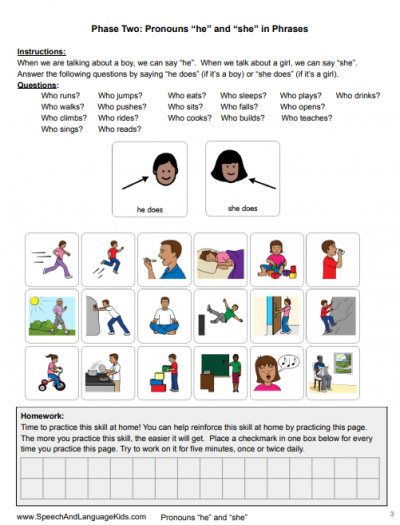Pronoun Games for Kids | Speech Therapy Activities
When a child is struggling to learn how to use grammatical markers, like pronouns and possessive pronouns, we can help with language boosting games and activities!
On this page, we’ll show you some simple games you can play to teach basic pronouns like “he”, “she”, and “they” to children. We’ll also show you how to work on these skills in speech therapy.
Pronouns Games:
What You’ll Need:
For these games, you’ll need dolls/figures or pictures of a boy and a girl. You’ll use those for the “he” and “she” in this game. You’ll also need some small objects (like toys) or pictures of objects that you can give to the boy and the girl.
How to Play:
Use the girl and the boy to practice using the pronouns “he” and “she” as well as “his” and “her”.
-
- Pronouns: Who wants this purse? …”He does” or “She does” or “They do”, “I want a ball”, “What do you want?”
-
- Possessive Nouns: Ask your child, “Whose is this?” Have your child respond with “the boy’s” or “the girl’s”. If this is too hard for your child, try having them show you something that belongs to the boy or girl, such as by saying “give me the boy’s ball”
-
- Possessive Pronouns: Ask your child, “Whose is this (are these)?” Have your child respond with ”His ball” or “Her hat” or “Their dogs”
Target concepts: he, she, they, I, you, his, her, their, hers, theirs, possessive ‘s
Other Grammar Games to Play:
- Plurals: Talk about what you or the child has “I have two monkeys”. Make sure your child gets the /s/ on the end of the word if she has more than one.
- Present Progressive: Give the boy or girl one object and then talk about what the child is doing with that object. For example, if you give the boy a food, talk about how “He is eating”
- Articles: Make sure your child is using the articles “the” and “a” when asking for things, like “I want the apple, please”. If he forgets, say it the right way and have him imitate it for you.
- Past tense: Ask your child, What just happened? Have her answer using a past tense verb, like “I put on an orange” or “He put on an orange”
- Conjunctions: If your child wants two things, make sure he uses the conjunction “and” by saying “I want a bike and a coat”
Answering Questions:
What do you want next? What is a food that is red? Where are you going to put the apple? What are you doing? Who gets this dress? Who wants a cat? Whose is this? How many foods does he have? How can you tell this is the girl? When do you eat (name a food on the board)? Function: Ask your child what you do with each item
Following Directions:
Practice following one-step and multi-step directions by asking your child to put on certain pieces in order. Ex: First, put on the apple. Then, put on the cup.
Adjectives:
- Receptive: Describe the piece you want your child to pick up. For example, you could say “give me the red, juicy, fruit.”
- Expressive: Have your child describe which piece she wants using descriptive vocabulary. You could ask your child “how does that apple taste?” or “what kind of food is that apple?”
* You can take turns giving and taking directions
Pragmatics:
- Bring two or more children together to work on the board.
- Make sure your child is taking turns with the other child. Have him ask for turns and give turns with the other child asks.
- Conversational Repair: Have your child give a direction to the other child. The second child must then either follow the direction or ask for clarification if he didn’t understand. This helps them understand they must be specific in their directions and it gives them practice asking for help or clarification when they don’t understand
Target Skills: Initiation (asking for a piece), topic maintenance, and maintaining joint attention with a peer (or adult)
Sorting:
Sort by one or two criteria:
- Have your child sort the pieces using one category, like “Give the foods to the girl and the clothes to the boy (1 criteria)”
- Have your child sort the pieces using two descriptors, such as “Give the salty foods to the boy and the sweet foods to the girl” (2 criteria-make sure there are pieces from other categories on the board so the child is not just sorting sweet vs. salty)
Describe Similarities and Differences:
- Explain how two pieces are alike and different. (They are both foods. This food is sweet and the other one is salty)

About the Author: Carrie Clark, MA CCC-SLP
Hi, I’m Carrie! I’m a speech-language pathologist from Columbia, Missouri, USA. I’ve worked with children and teenagers of all ages in schools, preschools, and even my own private practice. I love digging through the research on speech and language topics and breaking it down into step-by-step plans for my followers.
Connect with Me:




This looks great. Anxious to use it. Thanks!!
Wonderful! Let me know if you have any questions!!
This looks great. I cannot wait to see it. Jane
Wonderful! I hope you enjoy!
Clever idea. Thanks!
You’re Welcome!
I would love to download this, but the link is broken
It is possible that you are being blocked from downloading by your network. I’ve had other people tell me they’ve had trouble downloading at work for this reason. I would recommend either trying it at home or email me directly at speechandlanguagekids@gmail.com and I will email it to you. Sorry you’re having trouble!
Hi,this is a wonderful website with one stop solutions. Thank you making such useful resources available to us for free, it sure does make a difference in a special needs household
I’m definitely gonna start teaching my boy from your material and methodology. Will update on how it goes
Sounds great! Please let me know if you have any questions along the way!
I love how you have addressed so many language goals with this one set of materials.
Thank you!
Well, I’m not 100% sure what you’re upset about here so I’m going to take a guess. Are you upset that I used the term “they”? If so, please understand that the word “they” is a pronoun used in the English language to indicate that two or more people are being referenced. In the case of this game, there is a girl and a boy so there are two people who could potentially want the purse(s). There are two of each item so that you can practice using the pronoun “they” to indicate two people. This game does not include instructions about referring to one child as “they”, but rather, it includes the “they” pronoun as something that can be worked on in reference to two people.
That being said, I (Carrie Clark) as well as my company, Speech and Language Kids, fully support the rights of all individuals, including those who are transgendered or prefer to use gender-neutral pronouns. I do not happen to include the use of gender-neutral pronouns in any of my books or materials, but if this bothers you, then you probably shouldn’t do business with my company.